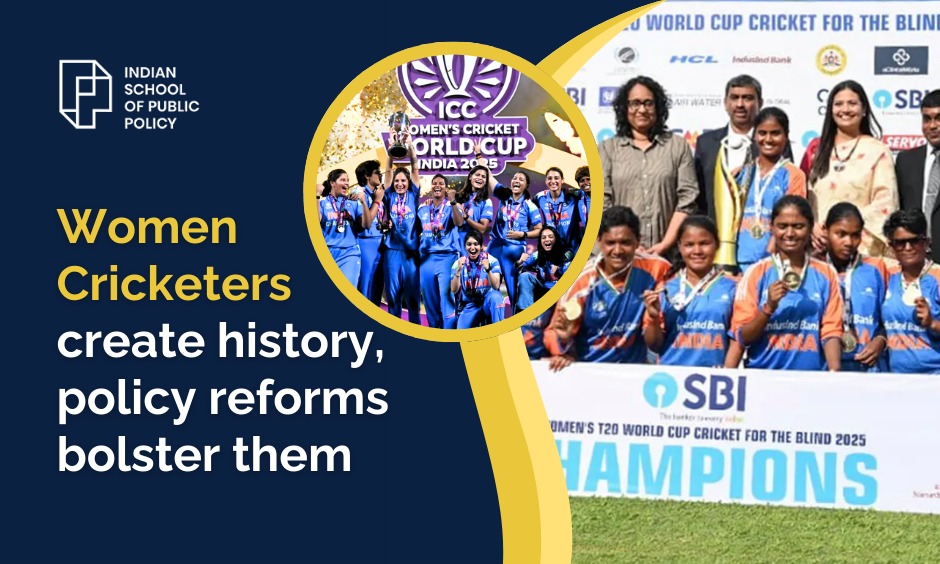Table of Contents
Women Cricketers create history, policy reforms bolster them

The historic milestone recently achieved by the Indian Women’s cricket team capturing their first ever ICC Women’s Cricket World Cup by defeating the South African team by a whopping 52 runs, was nothing short of splendor, resilience and dedication. Last week, Indian women cricketers achieved another milestone when India defeated Nepal by seven wickets in the Women’s T20 Cricket World Cup for the Blind 2025 in Colombo on 23rd November. These wins are the outcome of decades of tireless effort and policy evolution shaping them to the winners they are becoming.
A journey that began in 1973 with the establishment of the Women’s Cricket Association of India [WCAI], an organisation ahead of its time, defying societal norms of cricket being, “a gentlemen’s sport” is finally witnessing the fruits it sowed. WCAI nurtured the likes of Mithali Raj, Anjum Chopra, Jhulan Goswami amongst many others. However, before the merger with the Board of Control for Cricket in India (BCCI) in 2006, WCAI was constantly facing financial struggles.
In 2003, the distress over finances led the team to face travel and transport cost constraints to play in England for an upcoming series. It was then that celebrity Mandira Bedi, a passionate cricket supporter secured a sponsorship from a high-end jewellery brand, fees from which she donated to the WCAI, becoming a silent sponsor for the Indian women’s cricket team.
Certain rather obvious policy interventions came through the BCCI recognising that sports is a critical vector for gender equality and social inclusion. It brought in several reforms. This helped women players move from getting very low fees to being eligible for prize money as high as Rs. 51 crore and upwards.
The introduction of equal pay in 2022 made it clear that women players deserve parity not charity. Earlier in November, the BCCI announced a cash reward of Rs 51 crore for the players, support staff and selection committee, in recognition of the remarkable performance of the women’s team in the World Cup.
Behind success stories of Women’s cricket lie the relentless leadership of players like Mithali Raj, who captained the national team between 2004-22, and won several accolades, Jhulan Goswami, whose fast bowling won the respect of the world, besides young stars like Deepti Sharma, Jemimah Rodrigues and Shafali Verma during the 2025 World Cup.
India witnessed improvement in inclusivity through the introduction of Cricket Association for the Blind in 2010, which gained momentum through the Rights of Persons’ with Disabilities Act in 2016, mandating equal access sports, encouraging government bodies to support blind athletes with infrastructure, and other support. The recent win at Women’s T20 Cricket World Cup for the Blind is expected to provide a fillip to sportspersons with disabilities across states.
Supportive and enabling policies by state governments and BCCI have led to improved infrastructure, pay equity, cash rewards etc. The BCCI introduced a pay equity policy, ensuring women cricketers receive the same match fees as men for international matches in test series, one-day international and T20.
The Women’s Premier League (WPL) launched in 2023 provided women cricketers with a professional league for financial stability, and a wider audience. The BCCI has been investing in state-of-the-art training facilities, modern stadiums, and specialized coaching programs, besides investment in grassroots programmes. Also, the BCCI has established a dedicated Women’s Selection Committee to provide focused guidance for the women’s team.
Various state governments have rewarded these players with cash prizes, and provided recognition. For instance, West Bengal’s government announced that it will build a cricket stadium in Siliguri and name it after the wicket keeper Richa Ghosh. Madhya Pradesh Chief Minister Mohan Yadav announced a Rs 1 crore reward for Kranti Goud, who brought India pride in the World Cup 2025.
These victories are a powerful symbol of what is possible when inclusive public policy dismantles rigid systemic barriers and advocates gender equality. As the country celebrates its new champions, the deeper story is a call for sustenance and expansion of these reforms, across games, guaranteeing that wins are not an exception but the very foundation of enduring gender equality in sports and beyond.



